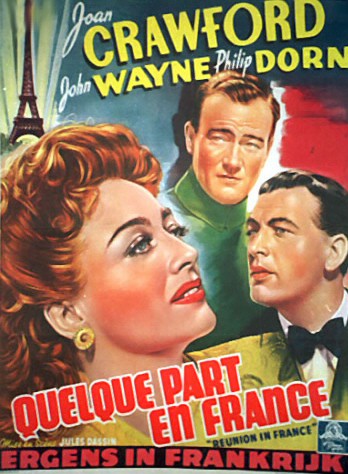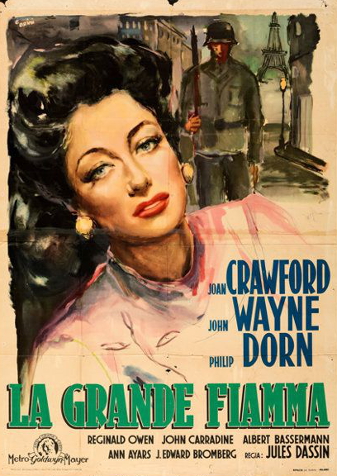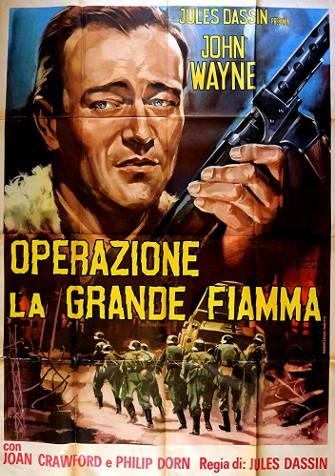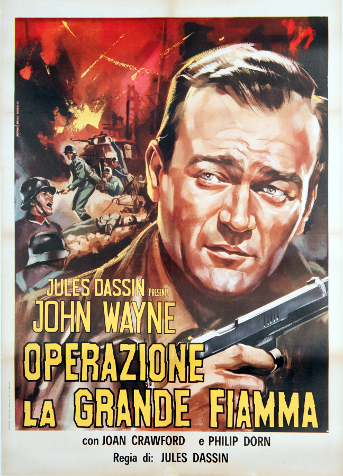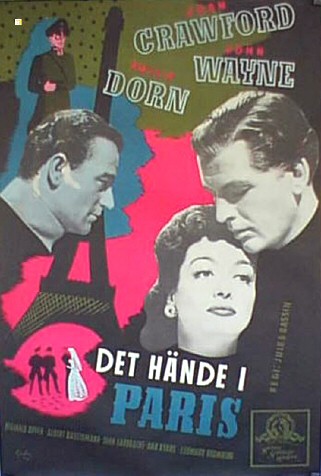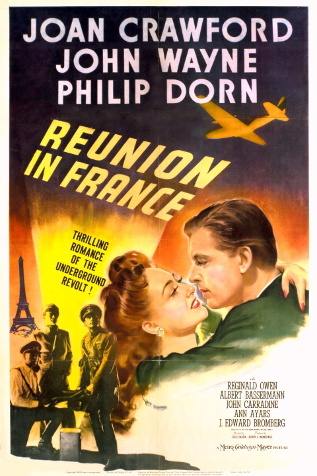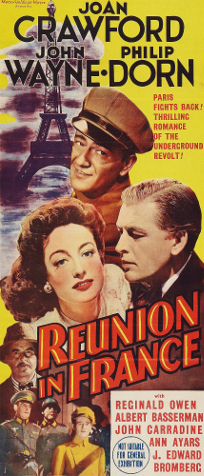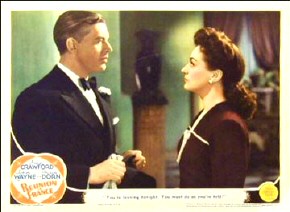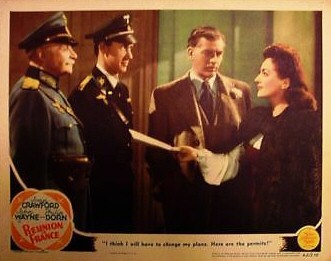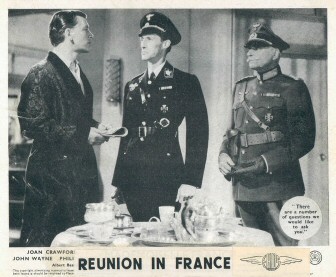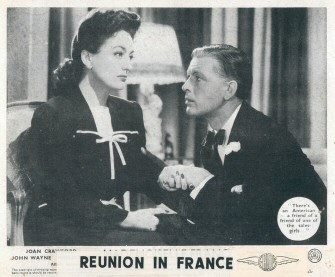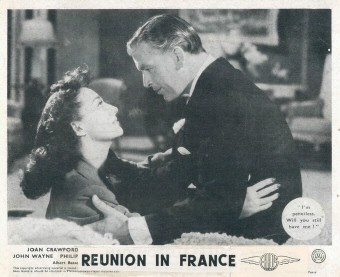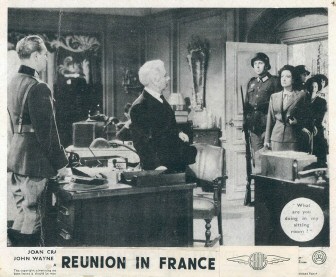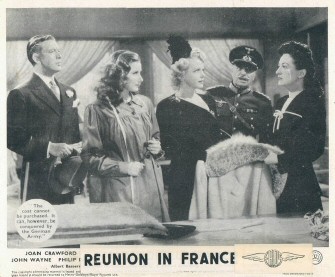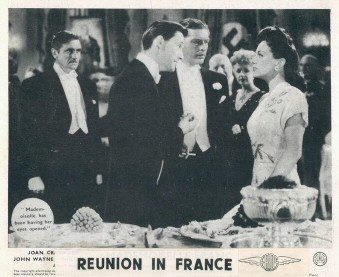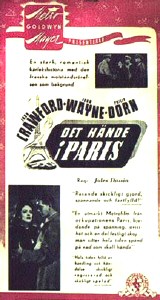 Tom C. (January
2025) Tom C. (January
2025)Rating:   -1/2 of 5 -1/2 of 5
As
I work through the final films of Joan’s MGM contract years, I am
struck by two things: First, I hate her hairdos! Second, the movies are
not as bad as I had feared. I had built up in my mind a mythos whereby Joan
got the dregs while plum roles went to Generation Next. That’s not to
say that in almost any retrospective these films would figure highly.
Joan has too many other career phases---20s flapper, 30s shopgirl,
40s/50s film noir queen, etc.--- that are more interesting. Her final few MGM films are just
OK, not great. As I watched Reunion in France (1942), I was struck by the dilemma that
it is good, but will always suffer by comparison in two respects:
First,
while this may be a career highlight for Philip Dorn, it’s unlikely a
top choice for fans of either star, JC or John Wayne. Joan had done iconic roles
before/after RIF, while Wayne was 3 years on from his breakout in Stagecoach and about a decade short of his heyday,
e.g., The Searchers (1956), one of the best Westerns made.
Second, RIF suffers by comparison in that it was released at roughly the same time as a WB flick that dealt with similar themes called Casablanca,
thought by many to be among the greatest Hollywood films. Other films
dealing with the French struggle against the Nazis pale in comparison. RIF has neither the wealth of compelling characters of Casablanca;
nor the emotionally impactful scenes; nor the plethora of great lines, misquoted and otherwise.
Random notes:
*
Early
in the film, keep an eye out for a young Mrs. Mickey Rooney---Ava
Gardner---in an uncredited appearance. She has one line, but you can see
she’s a knockout.
*
Lovey Howell, AKA Natalie Schafer, plays a 1940’s Karen, wife of a German general.
*
Favorite character actor, Henry Kolker---who goes back with Joan to 1925’s Sally, Irene and Mary---occupies a nano-sized role.
*
Philip
Dorn---an escapee from Hitler’s Europe---is good in this film as his
character falls into, out of, and back into love with France. And
with Joan/Marie.
*
RIF is directed by Jules Dassin. As
with Crawford and Wayne, this is a solid effort, but Dassin went on to more acclaimed work.
 Stephanie
Jones (July 2023) Stephanie
Jones (July 2023)
Rating:    of 5 of 5
OK, OK, it's no classic like Casablanca
(a Warners wartime film that was both shot and released around
the same time as this MGM wartime film).
But I still think it's a well-done
minor war propaganda film, well-acted by Joan and with some nice
touches by director Jules Dassin (in only the 4th film of his young
career).
The film opens with the title: "Paris,
May 9, 1940"---When the French still felt falsely safe behind
their Maginot Line and Joan's French heiress character "Michele
de la Becque" was still primarily concerned with being personally
fitted for her high-fashion clothing and conducting her affair with
French industrialist Robert Cortot (Philip Dorn). Michele is, at
this early stage, a Marie Antoinette-like thoughtless rich woman,
telling one salesgirl that if she has a blister after working all
day, she really must get her shoes custom-fitted. The salesladies'
general
comment re Michele: Mademoiselle seems annoyed at
the war. It's a wonder she doesn't permit it! Michele also has a few Scarlett O'Hara-like
moments, complaining about men and their war-war-war
obsession.
Soon after these early moments, an
air-raid siren sounds, and Michele is forced to flee the city, joining
thousands of others in the French countryside who are also trying
to escape the Nazis. Director Dassin here intersperses powerful
real-life footage of Nazi bombings and refugees. The flashing newspaper
headlines then tell what is happening/has happened: "Hitler
Invades Belgium and Holland," "Paris Falls," and
"France Asks for Armistice."
Michele eventually returns to Paris
to find her family home now a Nazi headquarters (she's offered the
former concierge's room in the home, which she accepts). When she
searches for her industrialist fiance, Cortot, she finds him
seemingly in cahoots with the Nazis, enjoying their parties and
fraternizing with their officers. We see massive candle-lit swastika-shaped
tables and Cortot behaving charmingly to Nazi officers and their
wives (including the uncredited Natalie Schafer---later Lovey Howell
in "Gilligan's Island"). Michele is horrified at what
she thinks Cortot has become, especially since her refugee ordeal
at the hands of the Nazis has changed her from a shallow rich woman
into a hard-core French patriot.
The mid-part of the film explores
wartime trust issues: Michele doesn't trust her fiance, and the
shopgirls don't trust the once-rich Michele, who shows up at the
department store where they work trying to find a job. Who's a Nazi
collaborator and who's not?
John Wayne doesn't appear until halfway
through the picture, as an injured RAF American Eagle Squadron pilot,
shot down in France, seeking refuge. At this point, we viewers know
that Michele is a French patriot, and when he approaches her on
a late-night street, she takes him in, pretending for German spies
that he's her drunken boyfriend that she's just met up with.
After a good night's sleep and some food, he's quickly coming on
to and kissing her, though their main goal is still to get
him out of there and back to Britain.
Wayne is perfectly cast as the down-to-earth
American. He calls Michele "Mike" and a drunken German
officer "Bub." When the drunken German officer spits on
him, he's quick to punch him out, which is exactly what a Good American
should do for appreciative American audiences!
Joan's best scene in the film is
after a drunken German officer has just come downstairs to her room
and discovered her with Wayne's American pilot. She goes from sincerely
kissing Wayne to seductively kissing the German to keep his attention
away from Wayne escaping. (Some great closeups of Joan here, also,
thanks to Dassin. Overall, she give hints of Joan-to-come, when
she would become more celebrated for her onscreen disdain---only
mildly on display here.)
Other highlights of the film:
* At the end of a shift at
the department store where Michele now works, one shopgirl's boyfriend
is playing Mendelssohn on his violin below the window. When Michele
identifies the composer, the girl rushes down to tell her beau that
Mendelssohn is "verboten" so he doesn't get in trouble.
Too late! Some German street police have already confronted him.
They ask him what he's playing. "Wagner," he lies. "Oh,
OK." They then ignorantly leave him alone.
* At the same French department
store, the customers are now shown as fat and tasteless German
women fighting over bargain-bin clothing.
* At a raucous elite German
party that Michele and her fiance Cortot attend, Michele charms
the Germans while a black American jazz band sings to the uncomprehending
Germans: "I'll be glad when you're dead,
you rascal, you. I'll be glad when you're dead, and Adolf, too..." (According to AFI, Buck Woods
is the singer.)
This film is way better than the ignorant
New York Times review suggests. For instance: "MGM seems somewhat off base when
it infers that the initiative for a French resurrection comes from its
moneyed society folk and spendthrifts; hardly an ordinary French
citizen appears in the film." --- Completely false and irrelevant to this
film. For one thing: Despite
the initial caveing in of the govt officials, the industrialist/capitalist
"Cortot" in this film secretly supports his country, as
did many of France's capitalists at the time. Without "moneyed
society" patriotism, there's no funding for the ground-base
Resistance. For another, Joan/Michele's
working-class department store cohorts are prominently featured
in the film, first mocking Michele for her initial pretentions and
later seeking to undermine the rich German women who have
become their new customers (then finally funding the American pilot's
escape from the country).
Overall, despite the critics' opinions
at the time (and Joan's own latter-day low opinion), I think Reunion
in France works just fine. It's a well-paced, well-told tale.
Joan is good as the shallow French heiress who becomes a patriot, John Wayne is good
as the "bub"-spouting/punching American pilot,
director Jules Dassin is good at his raw film insertions and Joan
close-ups, and the writers are good at their numerous interesting
character touches. COURAGE!
 Shane
Estes (June 2010) Shane
Estes (June 2010)
Rating:
  -1/2
of 5 -1/2
of 5
This film gets such a bum rap, and in my opinion undeservedly so.
It’s actually so much fun! Come on, John Wayne and Joan
Crawford? It’s brilliant! I think all parties involved did the
best they could with what they had to work with. Nobody wanted to do
this film! Crawford even stated that by this point she was so used to
getting bad scripts she “just surrendered. The fight was
gone.” The director Jules
Dassin hated the film from the beginning and was basically
forced into doing it. His ramblings about this film are quite amusing.
All the drama surrounding this project is hilarious. Apparently Joan
kept trying to move out of frame whenever she had a scene with Phillip
Dorn due to a previous affair, subsequently pissing off the director. He
was so angry the studio heads spent more time discussing hats than
anything else, and
it’s supposed to be a war movie! But alas, this is indeed a Crawford
picture, and hats are important damn-it!
Reunion in France
is a cute little wartime melodrama involving the transformation of a
spoiled aristocrat (Crawford) into a proud French nationalist, and it
comes off nicely. The cinematography is handsomely shot, and it looks like
this film really got the A-treatment. There’s nothing that looks cheap
about it. (The hats are definitely great!) Joan is always fun to look at,
but she’s exceptionally beautiful in this film. I love how she gets top
billing but the DVD is marketed as a “John Wayne movie,”
with his face towering
over everything on the cover, even though his part is actually not that
big and this film is a far cry from what most would consider a “John
Wayne movie.” One of the best scenes is where Crawford first
encounters Wayne, exhausted and delirious with hunger, trying to escape
the Gestapo. When she asks him who he is, he
replies with “Some kind of bird, maybe. No kidding, I fly, very low and
very slow, like a duck, maybe that’s what I am, a duck.” Wayne’s
character in this film is actually kind of funny. It works for the film. One thing I really admire about this movie is
its function as a protest film. It may be a little over-the-top in the
way that it stereotypes Germans, but it is a reflection of the times.
One of my favorite parts is when Crawford fearlessly stands up to the
Nazi commander who takes over her home. When
asked if she needs anything further, she replies, “As a matter of fact
there is, you and/or the German army… never mind, I’m sure it’s
punishable by death.” Another notable protest part is where the guy
outside the department store is playing Mendelssohn on a violin and two
Nazi guards walk by and ask what he is playing, to which he replies “Wagner.”
After they
leave, his girlfriend says “Idiot, what if he knew that was
Mendelssohn?” He answers, “He wouldn’t dare admit it.” Probably the best
piece of protest material
in this film, though, is at a Nazi banquet where there is a jazz band
made up of all-black members singing an anti-Hitler song with the line,
“I’ll be glad when you’re dead, you rascal you.”
As a side note, Natalie Schafer (Mrs. Howell) makes an
entertaining appearance as a Nazi wife. Didn’t you just love her in Female on the Beach
(1955)? I think she only plays one type of role; definitely a
character actress, but she does it well.
 Michael
Lia (January 2010) Michael
Lia (January 2010)
Rating:
 of 5
of 5
The older I get the sicker I get when I ride roller coasters
or drive on Highway One in California. It is weird -- a combination of
nausea and motion sickness, sprinkled with hot flashes. In fact I want
to throw up. Watching Reunion in France makes me feel the
same way. I thought I was a pro and could take any
genre. However, this film is painful: worse than the pain that Rhoda
Morgenstern received from her mother, but the word pain said in that
Jewish mother way.
Trog
is more watchable, and that is a different kind of pain. There are at
least ten major dogs in Miss Crawford’s cinematic history. This one
ranks very high. This film is not alone: ever view Miss Bette Davis’s
Satan Met a Lady or Winter Meeting? Katharine Hepburn in Jade? Ingrid Bergman in Saratoga Trunk?
I can give those five minutes and I then hit myself on the head. But as
always the difference with Miss Crawford is you could watch her even if
she was playing Wallace Berry’s grandmother! She is always able to make
you keep your eye on her!
Okay.Reunion in France is just awful and I have wrinkles on my forehead as
I write that. It is like rotten milk, spoiled eggs, brackish water, and
a hotel with no windows.
One
thing to remember: when the studio was good, it was out of this world;
when the studio is asleep and lazy and greedy, it is way off target and
can damage the universe. Shame on the producer (this is the same man
who would give us All about Eve in 1950). This time Miss Crawford was
just a piece of meat that poor Jules Dassin had to serve up. The writers must have been on the same roller coaster as I was.
MGM had already said good-bye to Miss Greta Garbo, Miss Norma Shearer, and even Myrna Loy and the beautiful Virginia Bruce
(never gave her a chance). It is evident that Miss Crawford's days at
the studio were numbered, and I am sure it was painful for her. I give
her a drug addict’s courage and strength for even showing up on the
set and speaking her dialogue.
If
the studio still had the interest and wanted to put out a good film,
they could have succeeded -- make Miss Crawford American and not French,
possibly working in Paris in the fashion industry and getting the
script involved realistically with the horrors of war. It could have been an engrossing drama or war film, a thriller, a spy yarn... anything but this crap.
Paris suffered hard during the Second World War. This is beyond silly.
But damn, everyone involved got a new Cadillac. Would I have done the same, Louella?
I know some of the character actors, but I will not waste the time on them; that day they just went to work. Only Natalie Schafer
stands out, and she turned out to be an old windbag, in later
interviews telling those “he had to eat the whole box of chocolates”
stories. And she wasn't even there. Thanks Mrs. Howell.
If
you like being dropped from a high-rise building or run over by an
automobile or locked in a closet with a stranger talking on their mobile
phone, then this film will be most enjoyable…Oh yeah: Miss Crawford wears
some beautiful gowns.
Watch
some documentaries on Paris during the war and you will die at the
MGM attitude; even the garbage cans in the alley are American. There is
nothing French about this film, and I still don’t get whose reunion it
is.
|
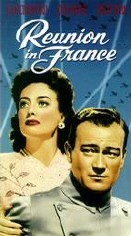
 MGM. 102 minutes.
MGM. 102 minutes.


 Shane
Estes (June 2010)
Shane
Estes (June 2010) Michael
Lia (January 2010)
Michael
Lia (January 2010)